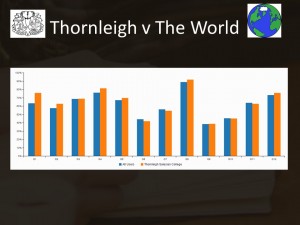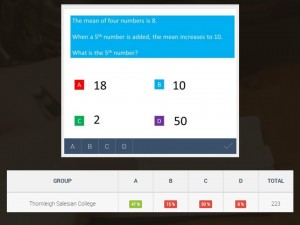What misconceptions do GCSE students have when it comes to more challenging questions about the mean of a set of numbers?
Each week we set all our Year 11 Higher GCSE students a GCSE Essential Skills Quiz from my Diagnostic Questions website. These quizzes are completely free and are designed to test the content that appears on the majority of GCSE higher maths papers. These are the kind of questions that students should get right, but which time and time again cost our Year 11s the valuable marks that prevent them getting the grade they want.
We set our quizzes on a Monday, the students complete them for Friday, and then I sit down with a Mellow Birds coffee and a yoghurt (it is the weekend, after all) to analyse the results. I try to find one key insight, and then share it with staff in our weekly Departmental Meeting in a 5 minute slot called “Insight of the Week”.
Quiz 5 is below, followed by the key insight from this week.
How our students performed compared to the rest of the world:
The two questions our students performed worst on involved a misreading of an enlargement scale factor question (Q9) and a common issue with straight line graphs (Q6). However, this week’s insight comes from the third worst answered question – a lovely one involving the mean of a set of data:
Over half of our Year 11 students got this question wrong, with option C tempting 30% of them.
Now, the reason I have selected this question above the other two is that if you ask most of our Year 11s how to calculate the mean from a set of data, they will proudly tell you – “add up the numbers and divide by how many numbers you have got”. And of course, they would be perfectly correct. But as this question clearly shows, all it takes is for the topic to be presented in a slightly unusual way, and that well rehearsed routine falls flat on its face. Furthermore, I have noticed an increasing number of these types of average questions sneaking their way into the more recent GCSE exams, so it is crucial that we identify the problem and rectify it as soon as possible.
Incorrect Answer B (15% of our students chose this)
This was the second most popular incorrect choice amongst our lot. Explanations given for this choice tended to ignore the key piece of information surrounding the mean of the first four numbers. Knowledge of how to calculate the mean was clearly evident, but an implicit assumption that all numbers are the same vale was being made.
“because 10 multiplied by 5 is 50 which you would then divide by 5 which would get you 10 which is the mean”
“Because 10 add 10 add 10 add 10 add 10 which equals 50 then divide by 5 which is 10!!!”
“lets assume that the 5th number is x , then (x+8)/2=10 solve the equation the 5th number is 10”
Incorrect Answer C (30% of our students chose this)
This option tempted almost a third of our Year 11s. Here, students are seeing that the mean has increased from 8 to 10, and thus making the jump that the two added on must in fact be the missing fifth number.
“2+2+2+2+2 = 10 10 divide 5 = 2”
“The mean has gone up by 2, so 2 is the missing number”
“The 5th number in the 2 times table is 10”.
Incorrect Answer D (8% of our students chose this)
Only a few of our students selected this option, but the reasons for it were very interesting. Some knowledge of what a mean of 10 from a set of 5 numbers tells you was evident, but the connection of with the mean of the first 4 numbers was missing.
“This is because you do the inverse.So you do 10 times by 5 which equals 50?”
“50 divided by 5 is 10”
“adding 10 everytime”
The Correct Answer!
One of my motivations for developing Diagnostic Questions was so that students all around the world could learn from each other. When your students finish a quiz, please encourage them to review their answers, reading through other students’ explanations, until they find the magic one that makes sense to them. So, what are our Year 11 students’ favourite correct explanations to help them resolve their own misconceptions?
“I think the answer is A because if you times the mean by 4 you get 32 and to get the mean to 10 the total has to be 50 so if you add 18 to 32 you get 50. Then you just divide 50 by 5 to get the mean of 10”
“because if the mean for numbers is 8 then the total of the numbers would 8×4=32 and if the mean of 5 numbers is 10 the total would 5×10=50 so to find the 5th number you would do 50-32=18”
“Something divided by 4 gets the answer 8 so 8 times 4 is 32. To find the 5th number you need to do 5 times 10 which is 50 then do 50 – 32 which is 18”
“the total has to be 50 for it to have a mean of 10 so the existing one was 32 and 32+18=50”
Tackling the Misconception in Class
So, when we discussed this insight in our Departmental Meeting, what ideas did we come up with for resolving the misconceptions in lessons this coming week with our students:
- Draw boxes for the 4 numbers and then play around with numbers until we get a set with a mean of 8. That should help the students spot the importance of the total being 32. Then do boxes for the 5 numbers, which should lead to the students spotting the importance of a total of 50.
- One colleague suggested setting up a formula triangle with Mean, Total and Numbers in it. If teachers have been taught SOHCAHTOA using these triangles, then they should see the link.
- Maybe begin with an investigation. Choose four numbers, work out the mean. Add a fifth number and see what happens to the mean. This should help put the question in a familiar context and encourage the students to have a go.
- Doing challenges such as “find 5 numbers with a mean of 6 and a median of 4” really help to develop the thinking needed for this type of question
Please add any extra ideas in the Comments section below!
The series of GCSE Essential Skills Quizzes are available here and will always be completely free.
Quiz 6 is available here
I hope these quizzes will prove useful to help your students develop the essential skills necessary for success at GCSE, and aid your teachers gain a deeper understanding of how your students learn.


